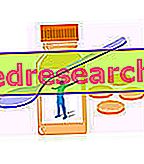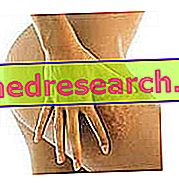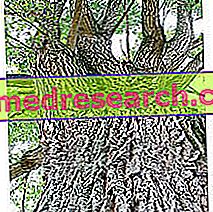Generality
The epitrocleite is the inflammation of the tendon complex that connects to the medial epicondyle of the humerus part of the anterior muscles of the forearm.

Epitrocleitis is caused by functional overload of the aforementioned muscles; in fact, the exaggerated and excessive stress of these muscles (functional overload), through a precise gesture, produces a stress on the connected tendons, so that the latter tend to become inflamed and become painful.
Particularly widespread in those who practice sports such as golf, tennis or baseball, epitrocleite is responsible for: pain on the inside of the elbow, joint stiffness on the elbow, weakness in the hand and wrist (only in some cases ), and numbness and tingling along the fingers.
Generally, the diagnosis of epitrocleitis is clinical, that is based on the story of the symptoms, on the physical examination and on the anamnesis.
As a rule, the treatment of epitrocleite involves a conservative cure, based on: rest of the suffering limb, ice packs, use of compressive bandages, use of a brace for the elbow, intake of anti-inflammatories and physiotherapy.
Short review of what a tendon is
A tendon is a band of fibrous connective tissue, with a certain flexibility and a high content of collagen, which unites a skeletal muscle to a bone.
What is Epitrocleite?
The epitrocleite is the painful condition, sustained by the inflammation of the tendons that connect part of the anterior forearm muscles to the medial epicondyle of the humerus .
Epitrocleite is an affection of the musculoskeletal system; more precisely, it is an example of tendinitis, or inflammation of one or more tendons.
Epitrocleite is also known as " golfer's elbow " and " medial epicondylitis ".
Epitrocleite is a very similar condition, albeit on the opposite side of the elbow, to lateral epicondylitis (or tennis elbow ).
Tendinitis is part of the large clinical group of tendinopathies, that is, of tendon diseases / suffering; also tendinopathy belongs to the tendinopathy group, ie chronic tendon affections sustained by a degeneration of the normal tendon structure.
To understand: a brief anatomical review
- The humerus is the equal bone of the human body which constitutes the skeleton of the arm, that is of the anatomical section between shoulder and elbow ;
- The humerus is a long bone, therefore on it are distinguishable 3 portions: the proximal epiphysis, the diaphysis and the distal epiphysis;
- Through the proximal epiphysis (which is the portion closest to the center of the human body), the humerus articulates with the scapula, to form the shoulder joint; through the distal epiphysis (which is the most distant portion from the center of the human body), instead, it is articulated with ulna and radium (bones of the forearm), to constitute the articulation of the elbow.
MEDICAL EPICONDILE OF THE HERO
Imagining that the upper limb is extended along the side and with the palm of the hand facing the observer, the medial epicondyle of the humerus is the prominence, perceptible to the touch, present on the inner side of the last stretch of the distal extremity of the bone constituting the skeleton of the arm.
The medial epicondyle of the humerus is important from the anatomical point of view, because it is the anchorage site of the tendon complex connected to the initial head of 5 of the 8 anterior forearm muscles.
FRONT MUSCLES OF THE FOREQUARTER

The anterior forearm muscles are a total of 8 ; these 8 muscles are arranged in 3 different depth planes:
- On the most superficial plane, there are 4 muscles, which are: the ulnar flexor of the carpus, the long palmar, the radial flexor of the carpus and the round pronator;
- On the intermediate level, there is only one muscle: the superficial flexor of the fingers;
- On the deepest plane, there are 3 muscles: the deep flexor of the fingers, the long flexor of the thumb and the square pronator.
For the understanding of this article on epitrocleite, only the anterior forearm muscles connected to the medial epicondyle of the humerus are of interest, namely: all the muscles of the superficial plane ( flexor carpi ulnaris, long palmar, radial carpus flexor and round pronator ) and the only muscle of the middle plane ( superficial flexor of the fingers ).
Origin of the name
The term "epitrocleite" derives from " epitroclea ", which is another name, coined by anatomists, to indicate the medial epicondyle of the humerus.
Causes
The cause of epitrocleite is the functional overload of the muscles that find themselves hooked onto the medial epicondyle of the humerus; in fact, the exaggerated and excessive stress of these muscles (functional overload), through a precise gesture, produces a stress on the connected tendons, so that the latter tend to become inflamed and become painful.
What movements of the upper limb produce Epitrocleite?
Epitrocleitis is inflammation of the tendons resulting from the excessive use of the muscles that allow:
- Wrist flexion;
- Flexing fingers to grab objects;
- The adduction of the wrist;
- The abduction of the wrist.
Therefore, the epitrocleite is the result of the exasperated and often combined repetition (ex: grasping an object with force and flexing the wrist) of the aforementioned gestures.
Who suffers the most from Epitrocleite?

Epitrocleite mainly affects:
- Golfers . Stimulation of the anterior forearm muscles is essential for swing movement;
- Who practices racket sports (eg: tennis). The gestures associated with epitrocleite (if, of course, performed at exasperation) are the reverse and topspin;
- Who practices throwing sports (eg baseball, softball or javelin throwing). The baseball player, for example, calls into question the muscles of the forearm involved in the epitrocleitis during the pitching movement;
- Who practices weight lifting . People dedicated to this activity flex their fingers to grab objects and, if the execution technique is not perfect, they could abduct or adduce the wrist slightly;
- Who carries out manual work, in the sectors of hydraulics, carpentry or construction.
Epitrocleitis Risk Factors?
To promote the appearance of epitrocleite are factors such as:
- The repetition, for over two hours and with an improper technique, of movements at risk;
- The use, in sports practices at risk, of inadequate equipment;
- Age over 40;
- Obesity;
- Cigarette smoke.
The execution technique of a potentially risky gesture is very important: if correct, in fact, it involves a lower stress on the front muscles of the forearm.
Symptoms and Complications
The typical symptoms of epitrocleite are:
- Pain and / or feeling of soreness on the inner side of the elbow. These are the most characteristic clinical manifestations;
- Sense of joint rigidity on the elbow;
- Sense of weakness in the hand and / or wrist. This is a disorder not always present;
- Numbness and / or tingling in the hand, especially fingers.
The epitrocleite tends to hit the dominant upper limb, therefore the right upper limb, for right-handers, and the left upper limb, for left-handed people.
Pain: how it appears and when it gets worse?

The most characteristic symptom of epitrocleitis - the pain on the inside of the elbow - can arise suddenly or gradually .
As happens in all the other forms of tendinitis, also in the epitrocleite the tenderness tends to worsen with the execution of those movements that recall to the action the muscles whose tendons are inflamed.
The use, for the purpose of a specific gesture, of a muscle whose tendon is inflamed feeds the inflammatory process to the latter and this results in a worsening of the symptomatology (especially the painful one).
When should I go to the doctor?
In the case of epitrocleitis, it is advisable to contact your doctor or contact an expert on diseases of the musculoskeletal system, when the symptoms (especially the pain and the sense of soreness) persist despite the rest.
Complications
In the absence of adequate treatment, epitrocleitis may develop into a more severe tendinopathy, characterized by an injury or a degeneration of the tendon structure.
The occurrence of the aforementioned complication involves chronic and debilitating symptoms, and requires specific medical intervention.
The chronic symptomatology and the debilitating effects of an epitrocleitis that has resulted in complications can strongly affect the patient's mood, as the latter has difficulty, due to pain, in performing the simplest movements with the affected upper limb.
Diagnosis
In general, the diagnosis of epitrocleitis is clinical, ie based on the patient's account of symptoms, physical examination and medical history ; it is possible, however, that this approach is insufficient and that, for the diagnostic confirmation of the current condition, the information provided by imaging tests, such as radiography, ultrasound and / or magnetic resonance imaging, are required.
Objective Examination

The physical examination consists in the medical observation, also through particular maneuvers and palpation, of the symptoms and signs that the patient complains or exhibits.
For those who complain of typical epitrocleite disorders, the physical examination includes a palpatory examination of the elbow and the execution, with the painful upper limb, of all those movements which, in the presence of inflammation, would evoke pain.
history
The anamnesis is the critical study of the symptoms noted during the physical examination and of the facts of medical interest collected through specific questions (concerning not only the symptomatology, but also the general state of health, habits, daily activity, diseases recurrent family, etc.).
In the presence of a condition such as epitrocleite, the anamnesis allows us to identify the factors that, in the given patient, have induced the inflammatory process.
Therapy
As a rule, epitrocleite treatment involves conservative treatment based on:
- Rest of the painful upper limb. In practical terms, the rest of the aching upper limb means that the patient must completely suspend the activity responsible for the current condition and avoid any similar practice.
The duration of rest varies from case to case, depending on the severity of the inflammation; surely, an important indicator of the benefits of rest is the total absence of pain on the occasion of movements with the upper limb which, at one time, caused pain;
- Applying ice on the painful area. If used in the right way, the ice has an incredible anti-inflammatory and pain-relieving power, especially at the beginning of an inflammation.
In general, the indications for its use are: 4-5 packs per day on the painful area (in the case of epitrocleite, it is the inner side of the elbow), for 15-20 minutes each (shorter or longer applications are ineffective) ;

- Applying a compressive bandage around the elbow. The compressive bandage mitigates pain and speeds healing;
- Use of a brace for the elbow . The brace for the elbow has the purpose of preserving the upper limb suffering from those movements that could further stress the tendons;
- Intake of a non-steroidal anti-inflammatory drug (NSAID) or paracetamol . The use of these drugs is indicated to calm inflammation and painful symptoms.
Among NSAIDs, the most commonly used by those suffering from epitrocleite is ibuprofen;
- Local injection of corticosteroids . Corticosteroids represent an alternative to NSAIDs and paracetamol, when the latter are ineffective and the symptoms persist.
The use of corticosteroids in the therapeutic management of epitrocleite is rare, due to the possible side effects related to the use of the drugs in question.
Please note that corticosteroids should be taken with a medical prescription;
- Physiotherapy exercises. Physiotherapy for epitrocleitis sufferers involves stretching and strengthening the muscles of the suffering upper limb.
To know exactly what these exercises consist of, it is good to contact an expert in the field, with experience in tendon problems.
Surgery: when can it be used?
Generally, epitrocleite does not require surgery.
However, if the symptomatology persists for over 6 months in spite of the conservative treatment described above or if the condition has evolved into a more severe tendinopathy, surgery becomes a viable therapeutic option .
Did you know that ...
Less than 10% of patients with epitrochleitis need surgery to resolve the condition.
Prognosis
As a rule, if treatment is timely, epitrocleite has a benign prognosis .
Recovery times vary from person to person, depending on the severity of the inflammation; however, in general, most patients with epitrocleitis recover within 3-4 weeks.
Return to activities after Healing: how should it happen?
After recovery, the resumption of the activities carried out before the appearance of the epitrocleite must take place gradually; failure to comply with this indication is strongly associated with relapses.
Prevention
Epitrocleitis prevention is based on:
- Do not exceed in the practice of sports activities at risk;
- When approaching for the first time a sporting activity at risk, be followed by an expert in the sector, in such a way as to learn the correct execution technique of all the foreseen movements;
- Implement the right muscle warming before starting any sport related to epitrocleite;
- Observe breaks during work activities or hobbies that put the muscles of the upper limbs to great strain;
- Equip yourself with quality equipment for the practice of sports activities at risk.
How to avoid aggravation of Epitrocleite
To prevent the worsening of epitrocleite it is essential to immediately abstain from any activity that evokes pain, even if the latter is bearable or controllable with an NSAID.



